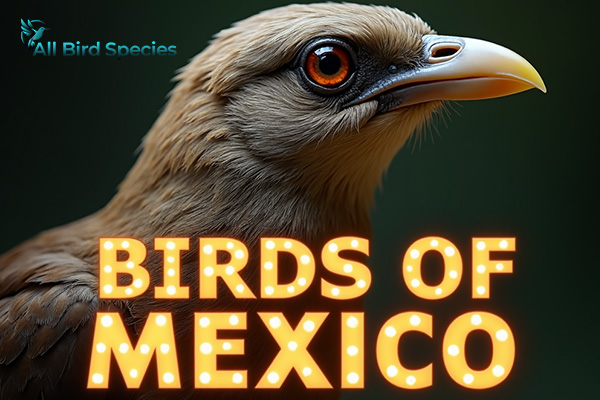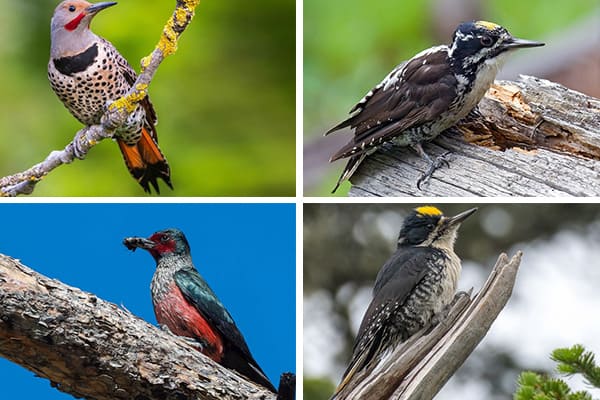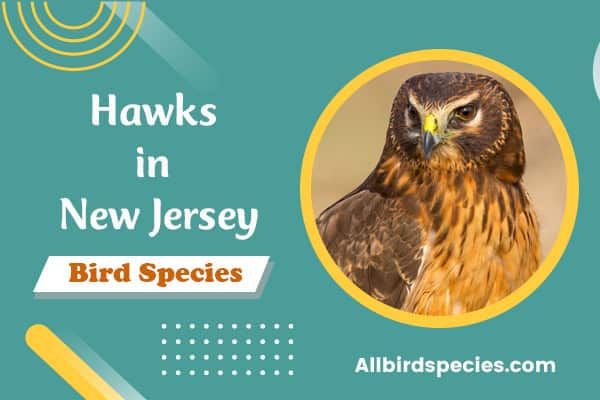8 Types of Woodpeckers in Georgia (With Pictures)
Hey there! I’m excited to tell you all about the nine types of woodpeckers you can find in Georgia. I’ve made special pictures to help you recognize them, and also I’ve gathered tons of info about each kind of woodpecker that lives in our state, including the sounds they make. So lets explore each type one by one.
So, in Georgia, most woodpeckers have a mix of black, white, and red feathers. You can tell the boys and girls apart by looking at the red spots on the backs of their heads. The boys have red spots, but the girls don’t.
Here We’ll Learn About Of 8 Types Of Woodpeckers In Georgia!!
1. Red-Headed Woodpecker
The red-headed woodpecker is an amazing bird that lives in Georgia. It’s really cool to look at because it has a bright red head and a pattern of black and white feathers that make it very special.
This bird can also live in many places. It likes open woods, places where people go to relax like parks, and it can even be found near homes. Also, it eats all sorts of things like bugs, fruits, and nuts, which means it’s good at finding different kinds of food to eat.

Identification and Behavior
The red-headed woodpecker boasts a medium-sized body, measuring about 7-9 inches in length. Its most distinctive feature is, of course, its fiery red head, which contrasts beautifully with its black wings and striking white underparts.
This woodpecker species is known for its agile flight and acrobatic foraging techniques. They can be seen hopping, climbing, and clinging to tree trunks as they search for food. Their strong beaks are perfect for excavating tree cavities, catching insects, and caching food for later consumption.
“The red-headed woodpecker’s striking appearance and distinctive behaviors make it a true symbol of Georgia’s woodpecker diversity.”
Habitat and Conservation
In Georgia, the red-headed woodpecker prefers open woodlands with mature trees, as well as forests near water sources. They often nest in tree cavities and live in loose colonies. However, the population of red-headed woodpeckers has faced some decline due to habitat loss and competition from invasive species.
To conserve this magnificent species, efforts are underway to protect and restore their preferred habitats. Creating artificial nest boxes and promoting responsible forest management practices are some of the strategies employed to support the conservation of red-headed woodpeckers in Georgia.
| Scientific Name | Common Name | Habitat | Conservation Status |
|---|---|---|---|
| Melanerpes erythrocephalus | Red-headed Woodpecker | Open woodlands, parks, residential areas | Near Threatened |
2. Red-Bellied Woodpecker
The red-bellied woodpecker is a common sight across Georgia, making it one of the most recognizable woodpecker species in the state. Despite its name, the red belly of this bird is often not easily visible. However, its vibrant red cap and zebra-like black and white back make it stand out among its feathered peers.
Found in a variety of habitats, including forests, woodlands, and suburban areas, the red-bellied woodpecker is known for its adaptable nature. It uses its strong beak to drum on trees, excavate nest cavities, and forage for food, primarily insects, nuts, and seeds.
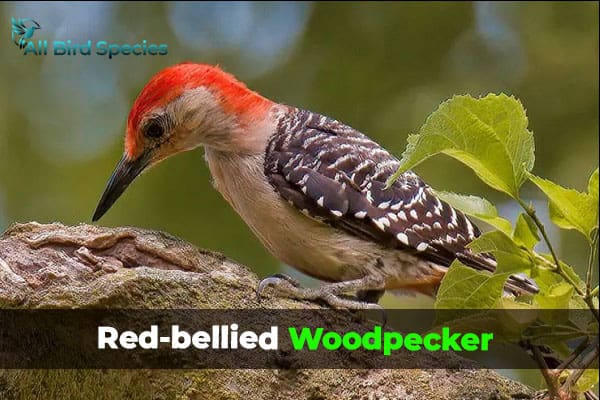
This woodpecker species is a skilled acrobat, capable of clinging to trees in various positions as it searches for its meal. It can also be seen propping its stiff tail against tree trunks for support while foraging.
“The red-bellied woodpecker’s unique characteristics and behaviors make it a remarkable species to observe in the wild.”
During courtship, the males of this species perform elaborate displays by drumming on trees and vocalizing to attract females. They also engage in “song battles,” where multiple males compete to see who can produce the loudest and most impressive calls.
To better understand the distinguishing features of the red-bellied woodpecker, let’s take a closer look:
Physical Characteristics
The red-bellied woodpecker measures approximately 9-10 inches in length. It has a black and white striped back, a red crown and nape, and a white face. The male further displays a bright red patch on the back of its head, while the female’s red patch is smaller and confined to the nape area.
Habitat and Range
This woodpecker species can be found across the eastern and southeastern regions of the United States, including Georgia. Its preferred habitats include mature forests, woodlands, and wooded suburban areas where it can find suitable nesting sites and abundant food sources.
From open woodlands to swampy areas, the red-bellied woodpecker demonstrates its adaptability by thriving in a range of environments.
Nesting and Reproduction
The red-bellied woodpecker typically excavates nesting cavities in dead trees or dead portions of live trees. It may also use man-made structures such as wooden utility poles or nest boxes. The male plays a significant role in attracting a mate by drumming loudly on trees near potential nesting sites.
Conservation Status
The red-bellied woodpecker is not currently listed as a species of conservation concern. It benefits from its adaptability to various habitats and human-altered environments. However, maintaining a healthy forest ecosystem and conserving suitable nesting sites are essential for the long-term survival of this species.
| Scientific Name | Common Name | Habitat | Range and Distribution |
|---|---|---|---|
| Centurus carolinus | Red-bellied Woodpecker | Mature forests, woodlands, and suburban areas | Eastern and southeastern regions of the United States, including Georgia |
3. Downy Woodpecker
The Downy Woodpecker is the smallest woodpecker species in Georgia, but its small size doesn’t diminish its impressive drumming abilities. This tiny yet fascinating bird showcases its talents by rhythmically tapping on trees.

As its name suggests, the Downy Woodpecker has delicate down-like feathers that cover its body. The black and white plumage of the male features a small red patch on the back of its head, while the female lacks the red patch.
The Downy Woodpecker shares many physical similarities with its larger relative, the Hairy Woodpecker. To differentiate between the two, look for the thin bill and short tail on the Downy Woodpecker, as well as its smaller overall size.
“The charming Downy Woodpecker is a frequent visitor to my backyard. I love watching its intricate drumming patterns on the trees, creating a beautiful rhythm in nature.”
The preferred habitat of the Downy Woodpecker includes woodlands, parks, and even urban areas with mature trees. It feeds mainly on insects, spiders, and tree sap, often foraging on tree trunks and branches in search of its next meal.
Behavior and Conservation
The Downy Woodpecker is known for its acrobatic climbing abilities, using its sturdy feet and sharp claws to grip onto tree bark while it forages for food. It also excavates small cavities in trees for shelter and nesting.
In terms of conservation, the Downy Woodpecker is not a species of immediate concern. Its adaptability to a range of habitats has allowed it to maintain stable populations throughout Georgia. However, the loss of mature trees and habitat fragmentation can pose threats to this species in the long run.
Interesting Facts
- The Downy Woodpecker’s drumming serves multiple purposes, including communication, mate attraction, and establishing territory.
- Despite its small size, the Downy Woodpecker can excavate nesting cavities in trees.
- Observing the Downy Woodpecker’s feeding behavior can provide insights into the health of a wooded area, as its presence indicates the presence of insects and other invertebrates.
Overall, the Downy Woodpecker is a delightful and fascinating bird to observe. Its small size and drumming skills make it a notable addition to Georgia’s woodpecker species.
4. Hairy Woodpecker
The hairy woodpecker, a close relative of the downy woodpecker, is a fascinating woodpecker species found in Georgia. With its distinctive features and behaviors, the hairy woodpecker is a captivating bird to observe.

When it comes to distinguishing between the hairy woodpecker and the downy woodpecker, there are a few key characteristics to look out for. While both species have black and white plumage, the hairy woodpecker is slightly larger, measuring around 9-10 inches in length, compared to the downy woodpecker’s 6-7 inch size.
Another distinguishing feature of the hairy woodpecker is its bill. Unlike the downy woodpecker, the hairy woodpecker has a longer bill, which is more robust and chisel-like in shape.
The hairy woodpecker can be found in a variety of habitats, including deciduous forests, woodlands, and even urban areas with mature trees. These woodpeckers are also known to frequent bird feeders, especially when provided with suet or other tasty treats.
Habitat and Behavior
Did you know? The hairy woodpecker’s diet primarily consists of insects, but they also feed on seeds, nuts, and fruits.
With its strong bill, the hairy woodpecker creates deep holes in tree trunks in search of prey. They use their long tongues to extract insects from the drilled holes, making them valuable contributors to pest control in forest ecosystems.
Unlike some other woodpecker species, the hairy woodpecker is less likely to drum on trees for communication. However, they do use their distinctive calls to communicate with other members of their species.
Here is an overview of the habitat and behavior of the hairy woodpecker:
| Habitat | Behavior |
|---|---|
| Deciduous forests | Creates deep holes in tree trunks |
| Woodlands | Feeds primarily on insects |
| Urban areas with mature trees | Uses distinctive calls for communication |
The hairy woodpecker is a captivating woodpecker species that adds vibrancy to Georgia’s avian life. Whether you spot one in the forest or in your own backyard, take a moment to appreciate the beauty and unique behaviors of this remarkable bird.
5. Pileated Woodpecker
The Pileated Woodpeckers is an incredible and majestic bird found in the beautiful state of Georgia. As the largest woodpecker species in Georgia, it is truly a remarkable sight to behold.
With its striking appearance and distinct features, the Pileated Woodpecker stands out among its avian counterparts. Its distinctive red crest and powerful beak make it easily recognizable. When it takes flight, its impressive size and striking black body with white markings become even more evident.
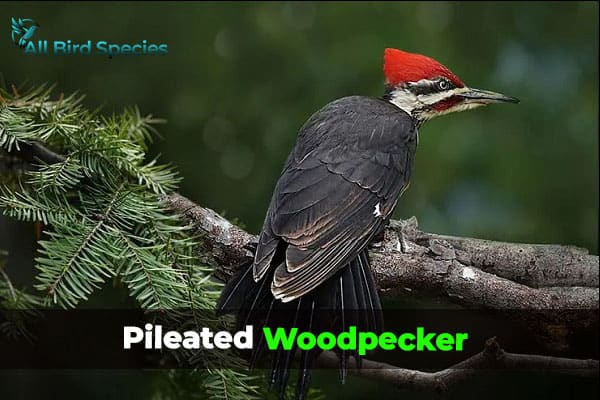
The Pileated Woodpecker is known for its loud and distinct calls that echo through the forests of Georgia. These calls serve as territorial markers and can often be heard from a distance.
This fascinating bird has a unique and varied lifestyle. It primarily feeds on ants, termites, beetles, and other insects found in dead or decaying trees. It uses its strong beak to probe and excavate deep into the wood, leaving behind characteristic rectangular holes as evidence of its foraging activities.
“The Pileated Woodpecker is a symbol of the vitality and diversity of Georgia’s forests. Its presence serves as a reminder of the importance of preserving these habitats for future generations.”
The Pileated Woodpecker can be found primarily in mature forests with large trees, as it relies on these trees for nesting and foraging. It excavates large cavities in dead trees for nesting, which provide shelter for its young and protection from predators. These cavities are also used by other bird species and animals, contributing to the overall biodiversity of Georgia’s forests.
| Characteristics | Habitat | Behavior |
|---|---|---|
| The largest woodpecker species in Georgia | Mature forests with large trees | Excavates rectangular holes for foraging |
| Distinct red crest and powerful beak | Builds nesting cavities in dead trees | Loud and distinct calls for territorial marking |
| Feeds on insects found in decaying wood | Provides shelter for young and other species | Contributes to overall forest biodiversity |
6. Red-Cockaded Woodpecker
The red-cockaded woodpecker is a fascinating species that requires special attention and conservation efforts in Georgia. This woodpecker, scientifically known as Picoides borealis, is listed as an endangered species due to habitat loss and fragmentation.
As its name suggests, the red-cockaded woodpecker has a small red “cockade” or streak of red feathers on the sides of its black cap. This distinctive feature helps identify these birds in the wild. Woodpeckers in Georgia rely on mature pine forests for their habitats, as they create cavities in living pine trees for their nesting and roosting purposes.

The adaptation of using living pine trees for their nests is unique to the red-cockaded woodpecker. These birds drill cavities in trees with their strong beaks, and they depend on the resin produced by the trees to help deter predators. The sap, known as “pitch,” flows down the tree, creating a barrier that deters snakes, squirrels, and other potential threats from reaching the nesting cavity.
Conservation efforts for the red-cockaded woodpecker mainly focus on preserving and restoring their habitat. This includes the protection of mature pine forests and the establishment of artificial nesting cavities in suitable areas. Collaborative initiatives between government agencies, conservation organizations, and private landowners are crucial in ensuring the survival and recovery of this unique woodpecker species.
Through these conservation efforts, there has been some positive progress in the recovery of the red-cockaded woodpecker population in Georgia. However, continued efforts are necessary to ensure the long-term survival of these birds and their habitats.
7. Yellow-Bellied Sapsucker
The yellow-bellied sapsucker, a unique woodpeckers species found in Georgia, plays a vital role in the state’s ecosystem. With its distinct name and fascinating habits, this bird is a true marvel.
Unlike other woodpeckers, the yellow-bellied sapsucker is known for creating sap wells on trees. These wells serve as a valuable food source for the sapsucker, as well as other wildlife like hummingbirds and insects. By drilling small holes in trees, the sapsucker allows sap to flow, attracting insects that are subsequently consumed. This behavior not only sustains the sapsucker but also contributes to the overall health of the forest ecosystem.

In addition to its sap wells, the yellow-bellied sapsucker exhibits interesting migratory patterns in Georgia. These birds are known to breed in northern areas during the summer months before migrating south to Georgia for the winter. The state’s mild climate and abundant food sources make it an ideal destination for these migratory woodpeckers.
“The yellow-bellied sapsucker’s role as a ‘tree doctor’ is crucial for the well-being of Georgia’s forests. Through its unique feeding habits, it helps maintain the delicate balance of nature and supports a thriving ecosystem.” – Dr. Jane Wilson, Ornithologist
To further understand the yellow-bellied sapsucker’s habits and contributions, let’s take a look at the following table that provides key insights into this remarkable bird:
| Common Name | Scientific Name | Habitat | Migration |
|---|---|---|---|
| Yellow-Bellied Sapsucker | Sphyrapicus varius | Forests, woodlands | Seasonal, migratory |
As seen in the table above, the yellow-bellied sapsucker is scientifically known as Sphyrapicus varius. Its preferred habitat includes forests and woodlands, where it can find suitable trees for drilling sap wells. The sapsucker’s migratory behavior adds to the dynamic nature of Georgia’s avian population, with these birds traveling to the state during the winter months.
8. Northern Flicker
The northern flicker is a special kind of woodpeckers that lives in different parts of Georgia. These birds have a unique look: their upper body is brown with white spots, and they have a black belly with bars. The male northern flicker even has a black mustache mark on its face, which makes it look even more interesting.
One cool thing about the northern flicker is the sound it makes. It drums on trees or other surfaces really fast, creating a unique noise. Why does it do this? Well, it has a few reasons: to find a mate, protect its territory, and talk to other flickers.

When it comes to food, the northern flicker has a varied diet. It loves eating insects like ants and beetles, which it finds by using its long, barbed tongue to dig into trees. But guess what? These woodpeckers also enjoy fruits, berries, and seeds.
As for where they live, northern flickers can be found in different places. They like forests, woodlands, and even suburban areas with enough trees. But here’s an interesting twist: they really like dead or decaying trees. Why? Because those trees are perfect for nesting and finding food.
| Specifications | Details |
|---|---|
| Scientific Name | Colaptes auratus |
| Size | approximately 11-14 inches long |
| Wingspan | approximately 17-20 inches |
| Habitat | Forests, woodlands, suburban areas |
| Main Diet | Insects, fruits, berries, seeds |
| Distinctive Features | Distinctive plumage, drumming sounds |
So, keep an eye out for the northern flicker during your outdoor adventures in Georgia! Their eye-catching appearance and rhythmic drumming are sure to make your birdwatching experience even more memorable.
Check Our Previous Articles
Frequently Asked Questions About Woodpeckers of Georgia
Q1: What attracts woodpeckers to your house?
Woodpeckers are attracted to houses for several reasons, including the presence of insects in the wood, the availability of nesting sites, and the resonance of hollow spaces for drumming.
Q2: Are red-headed woodpeckers protected in Georgia?
Yes, red-headed woodpeckers are protected under state and federal laws in Georgia due to their declining populations and habitat loss.
Q3: What months are woodpeckers most active?
Woodpeckers are generally most active in the spring and summer months when they are breeding and foraging for insects to feed their young.
Q4: Where to find red cockaded woodpeckers in Georgia?
The red-cockaded woodpecker can be found in longleaf pine forests in Georgia, particularly in areas with mature pine trees and suitable habitat for cavity nesting. They are often associated with protected areas and managed forests.


